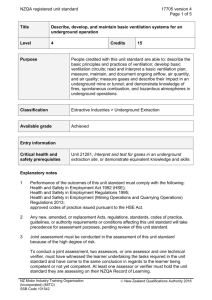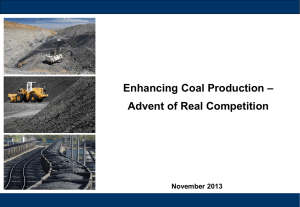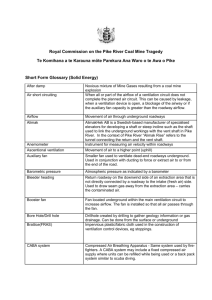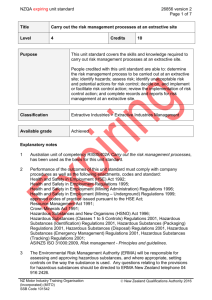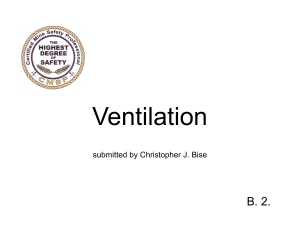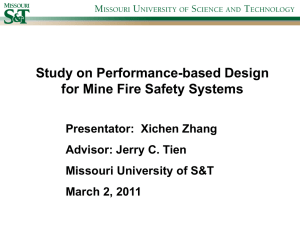21280 Demonstrate knowledge and evaluate the design of
advertisement
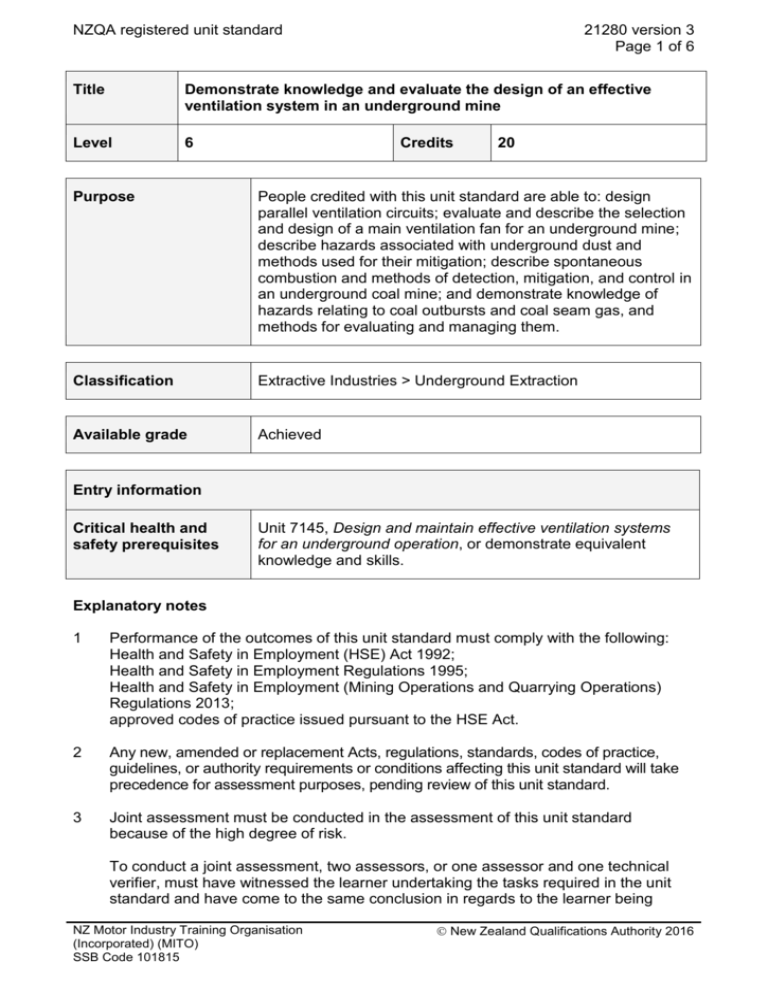
NZQA registered unit standard 21280 version 3 Page 1 of 6 Title Demonstrate knowledge and evaluate the design of an effective ventilation system in an underground mine Level 6 Credits 20 Purpose People credited with this unit standard are able to: design parallel ventilation circuits; evaluate and describe the selection and design of a main ventilation fan for an underground mine; describe hazards associated with underground dust and methods used for their mitigation; describe spontaneous combustion and methods of detection, mitigation, and control in an underground coal mine; and demonstrate knowledge of hazards relating to coal outbursts and coal seam gas, and methods for evaluating and managing them. Classification Extractive Industries > Underground Extraction Available grade Achieved Entry information Critical health and safety prerequisites Unit 7145, Design and maintain effective ventilation systems for an underground operation, or demonstrate equivalent knowledge and skills. Explanatory notes 1 Performance of the outcomes of this unit standard must comply with the following: Health and Safety in Employment (HSE) Act 1992; Health and Safety in Employment Regulations 1995; Health and Safety in Employment (Mining Operations and Quarrying Operations) Regulations 2013; approved codes of practice issued pursuant to the HSE Act. 2 Any new, amended or replacement Acts, regulations, standards, codes of practice, guidelines, or authority requirements or conditions affecting this unit standard will take precedence for assessment purposes, pending review of this unit standard. 3 Joint assessment must be conducted in the assessment of this unit standard because of the high degree of risk. To conduct a joint assessment, two assessors, or one assessor and one technical verifier, must have witnessed the learner undertaking the tasks required in the unit standard and have come to the same conclusion in regards to the learner being NZ Motor Industry Training Organisation (Incorporated) (MITO) SSB Code 101815 New Zealand Qualifications Authority 2016 NZQA registered unit standard 21280 version 3 Page 2 of 6 competent or not yet competent. At least one assessor or verifier must hold the unit standard they are assessing on their NZQA Record of Learning. 4 Due to the high degree of risk associated with this unit standard, the assessment process must include a learner interview with one or both assessors. 5 Definitions Company procedures mean the documented methods for performing work activities and include health and safety, operational, environmental, and quality management requirements. They may refer to legislation, regulations, guidelines, standard operating procedures, manuals, codes of practice, or policy statements. Industry best practice may be documented in management plans, control plans, company procedures, managers’ rules, occupational health and safety policy, industry guidelines, codes of practice, manufacturers’ instructions, and safe working and/or job procedures (or equivalent). 6 An underground operation includes extractive or tunnelling operations. 7 This unit standard is intended for, but is not limited to, workplace assessment. Outcomes and evidence requirements Outcome 1 Design parallel ventilation circuits. Evidence requirements 1.1 Design meets requirements of approved codes of practice and industry best practice. 1.2 Airflows in parallel circuits are calculated in accordance with industry best practice and approved codes of practice. Range 1.3 Ventilation control devices (VCDs) are selected and positioned to ensure optimal atmospheric conditions for mine operation. Range 1.4 includes but is not limited to – regulator location, regulator aperture size, efficiency, quantity, resistance, split limits, Atkinson formula, air pressure, kinetic energy, static energy, friction loss, airpower, Bernoulli’s equation. includes but is not limited to – main fan, air intake, return airflow, stoppings, seals, air crossing, regulators, doors, auxiliary fan, air mover, brattice leads. Natural ventilation is described in terms of atmospheric conditions and ventilation systems in mine operations. Range geothermal gradient, atmospheric temperature, ascensional and descensional ventilation. NZ Motor Industry Training Organisation (Incorporated) (MITO) SSB Code 101815 New Zealand Qualifications Authority 2016 NZQA registered unit standard 21280 version 3 Page 3 of 6 Outcome 2 Evaluate and describe the selection and design of a main ventilation fan for an underground mine. Evidence requirements 2.1 Mine ventilation needs are evaluated. Range 2.2 Fan selection is described and evaluated in accordance with the mine ventilation needs and manufacturer’s specifications. Range 2.3 includes but is not limited to – pressure-quantity survey, mine pressure differential, mine resistance, fan evasée, number of air splits, ventilation system efficiency, leakage. may include but is not limited to – axial fan, radial (centrifugal) fan, pressure generation, fan efficiency, fan characteristics, fan curves, blade configuration and number, motor and drive power, type and efficiency, monitoring instrumentation, alarm settings, interlocks, communication. Main fan portal and housing design is described and evaluated in accordance with industry best practice. Range may include but is not limited to – pressure release doors, airlock doors, strength rating, return road area and profile, resistance, effective guarding and fencing, electricity main feed and backup supply, monitoring equipment, interlocks, door activation. Outcome 3 Describe hazards associated with underground dust and methods used for their mitigation. Evidence requirements 3.1 Hazards associated with underground dust are described in terms of personnel and site safety. Range 3.2 includes but is not limited to – explosions, fire, pneumoconiosis, visibility, respirable and irrespirable dust, diesel particulate matter. Methods for mitigation of hazards are described in accordance with industry best practice and company procedures. Range includes but is not limited to – stone dust, water barriers, water sprays, filters, chemical dust suppression, ventilation system, dust removal, personal protective equipment, sampling and analysis. NZ Motor Industry Training Organisation (Incorporated) (MITO) SSB Code 101815 New Zealand Qualifications Authority 2016 NZQA registered unit standard 21280 version 3 Page 4 of 6 Outcome 4 Describe spontaneous combustion and methods of detection, mitigation, and control in an underground coal mine. Evidence requirements 4.1 Spontaneous combustion, and factors which promote it, are described in terms of their mechanisms. Range includes but is not limited to – oxidation, particle size, coal accumulations, coal age, rank, moisture, pressure differential, ventilation system, airflow, incubation period, occluded gases. 4.2 The development of company procedures and plans to eliminate or minimise risks of spontaneous combustion is described and evaluated in accordance with industry best practice. 4.3 Methods of detecting, interpreting, and controlling spontaneous combustion are described in accordance with industry best practice. Range 4.4 may include but is not limited to – Boyle’s law, Charles’s law, Combined Gas law, Coward’s Triangle, Ellicott’s diagram, JonesTrickett’s ratio, carbon monoxide (CO) make by volume, gas trends, coal dust, remote and portable detection equipment. The interpretation and quantification of the level of risk and potential outcomes associated with spontaneous combustion are described in accordance with industry best practice. Outcome 5 Demonstrate knowledge of hazards relating to coal outbursts and coal seam gas, and methods for evaluating and managing them. Evidence Requirements 5.1 Methods for determining the seam gas content of a coal seam are described and evaluated. Range 5.2 includes but is not limited to – inseam gas sampling and analysis, insitu gas pressure, gas make by volume, gradient and elevation of mine workings. Methods for controlling the seam gas content of a coal seam are described and evaluated in accordance with industry best practice. Range includes but is not limited to – drilling equipment and systems, gas drainage systems, pipeline capacity, pipeline strength, pressure, suction pumps, gas discharge, safety features and equipment, gas monitoring, flow monitoring, safety valves, stuffing boxes, alarms, interlocks, operational controls, effect on the mine environment. NZ Motor Industry Training Organisation (Incorporated) (MITO) SSB Code 101815 New Zealand Qualifications Authority 2016 NZQA registered unit standard 5.3 The propensity for coal outbursts and the conditions where outburst may occur are described and evaluated in accordance with industry best practice. includes but is not limited to – inseam gas content, insitu gas pressure, gas make by volume, gas desorption rate, gradient and elevation of mine workings, depth of mine workings, strata type, coal rank, coal specifications (including fusinite content, strength), impermeable geological barriers, strata and coal permeability and porosity. Range 5.4 21280 version 3 Page 5 of 6 Methods for controlling the outburst risk are described and evaluated in accordance with industry best practice. includes but is not limited to – analysis of strata, mylonite, in seam drilling equipment and systems, gas drainage systems, pressure, safety valves, stuffing boxes, alarms, interlocks, operational controls, effect on the mine environment. Range Replacement information Planned review date This unit standard replaced unit standard 7169. 31 December 2019 Status information and last date for assessment for superseded versions Process Version Date Last Date for Assessment Registration 1 24 November 2005 Rollover and Revision 2 16 July 2010 Review 3 18 June 2015 31 December 2017 31 December 2017 N/A Consent and Moderation Requirements (CMR) reference 0114 This CMR can be accessed at http://www.nzqa.govt.nz/framework/search/index.do. Please note Providers must be granted consent to assess against standards (accredited) by NZQA, before they can report credits from assessment against unit standards or deliver courses of study leading to that assessment. Industry Training Organisations must be granted consent to assess against standards by NZQA before they can register credits from assessment against unit standards. Providers and Industry Training Organisations, which have been granted consent and which are assessing against unit standards must engage with the moderation system that applies to those standards. NZ Motor Industry Training Organisation (Incorporated) (MITO) SSB Code 101815 New Zealand Qualifications Authority 2016 NZQA registered unit standard 21280 version 3 Page 6 of 6 Requirements for consent to assess and an outline of the moderation system that applies to this standard are outlined in the Consent and Moderation Requirements (CMR). The CMR also includes useful information about special requirements for organisations wishing to develop education and training programmes, such as minimum qualifications for tutors and assessors, and special resource requirements. Comments on this unit standard Please contact the NZ Motor Industry Training Organisation (Incorporated) (MITO) info@mito.org.nz if you wish to suggest changes to the content of this unit standard. NZ Motor Industry Training Organisation (Incorporated) (MITO) SSB Code 101815 New Zealand Qualifications Authority 2016
